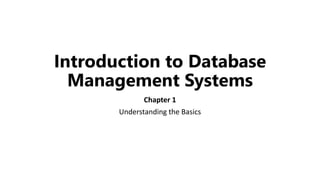Introduction to Database Management Systems.pptx
In the modern digital era, information plays a crucial role in every aspect of our lives. Businesses, organizations, and individuals generate and consume vast amounts of data daily. Managing this data efficiently is essential for making informed decisions, ensuring data integrity, and supporting various applications. A Database Management System (DBMS) is a specialized software designed to facilitate this task. A database is a structured collection of data that is organized and stored in a way that allows for efficient retrieval and manipulation. It serves as a centralized repository for storing and managing data, providing a systematic and organized approach to handling information. The primary goal of a database is to provide a reliable and efficient method for data storage, retrieval, and management.

Recommended
Recommended
More Related Content
Similar to Introduction to Database Management Systems.pptx
Similar to Introduction to Database Management Systems.pptx (20)
Recently uploaded
Recently uploaded (20)
Introduction to Database Management Systems.pptx
- 1. Introduction to Database Management Systems Chapter 1 Understanding the Basics
- 2. Understanding Databases • Title: What is a Database? • Definition: A structured collection of data for efficient storage and retrieval • Importance: Centralized repository for managing information • Image: Graphic representation of a database structure
- 3. What is a DBMS? • Title: Database Management System (DBMS) • Definition: Software facilitating data capture, analysis, and management • Components: DDL, DML, Query Language, Transaction Management, Concurrency Control • Image: Diagram highlighting key components
- 4. Data Definition Language (DDL) • Title: DDL in a Nutshell • Functions: Defining database structure, relationships, and constraints • Examples: CREATE TABLE, ALTER TABLE, DROP TABLE • Image: Sample DDL commands
- 5. Data Manipulation Language (DML) • Title: DML Operations • Functions: Querying, updating, inserting, deleting data • Examples: SELECT, UPDATE, INSERT, DELETE • Image: Sample DML queries
- 6. Query Language • Title: SQL - Structured Query Language • Significance: Standard language for interacting with relational databases • Image: SQL code snippets and a query execution illustration
- 7. Transaction Management • Title: Ensuring Data Consistency • Definition: Sequences of operations executed as a single unit • Role: Maintaining data integrity, even in the face of system failures • Image: Transaction flowchart
- 8. Concurrency Control • Title: Managing Concurrent Access • Definition: Mechanisms like locking to handle simultaneous database access • Importance: Ensuring data consistency in multi-user environments • Image: Visual representation of concurrency control
- 9. Advantages of Using a DBMS • Title: Unlocking Benefits • Points: Data integrity, security, data independence, efficient retrieval, centralized data management • Image: Icons or illustrations representing each advantage
- 10. Types of DBMS • Title: Categorizing Database Management Systems • Categories: Relational DBMS (RDBMS), NoSQL DBMS • Examples: MySQL, PostgreSQL, MongoDB, Cassandra • Image: Logos or graphics representing each category
- 11. Conclusion • Title: Wrapping Up • Summary: Recap of key concepts covered • Call to Action: Explore advanced topics in upcoming chapters • Image: Closing visual or a "Thank You" message